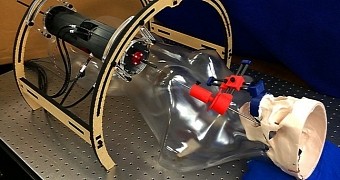Earlier this week, researchers with the US' Vanderbilt University introduced the world to an innovative surgical robot that they say makes it possible to operate on the brain without having to first drill into a patient's skull.
While at the Fluid Power Innovation and Research Conference in Nashville, mechanical engineering expert David Comber showcased the working prototype put together by him and his colleagues, and explained its working principles.
As detailed by the researcher, the robot is designed in such ways that it can enter a patient's body through the cheek and then work its way towards the brain. Having reached the target organ, the robot can operate on it.
To get a better idea of what the robot looks like when at work, check out the photo accompanying this article. The image shows the working prototype developed by the Vanderbilt University scientists pretending to operate on a dummy.
The surgical robot's anatomy
The specialists behind this research project explain that the anatomy of their robot includes a needle that is made from nickel-titanium. This alloy was chosen due to the fact that it is compatible with MRIs.
The needle measures precisely 1.14 millimeters (0.044 inches) in thickness, and is pushed deeper inside a patient's body with the help of compressed air. The equipment releasing the air is so precise that the needle can be made to move forward at a rate of just 1 millimeter (0.039 inches) at a time.
With the help of several concentric tubes, the needle can be steered with a high degree of accuracy and compelled to follow a curved path when working its way towards the brain and then inside it. To make sure that all is going according to plan, its position can be determined at all times using MRI scans.
Having carried out a series of laboratory experiments, the Vanderbilt University researchers found the system to have an accuracy of more than 1.18 millimeters (0.046 inches) in terms of reaching its target. Hence, the system was deemed safe for use in surgery.
Interestingly enough, it appears that such robots can be put together not just in the conventional take-a-hammer-and-hit-something-with-it kind of way, but also using 3D printing. In fact, it is argued that 3D printing such robots is sure to reduce manufacturing costs.
Commenting on the development of this innovate equipment for operating on the human brain, Associate Professor of Neurological Surgery Joseph Neima pointed out that “The systems we have now that let us introduce probes into the brain – they deal with straight lines and are only manually guided.”
“To have a system with a curved needle and unlimited access would make surgeries minimally invasive. We could do a dramatic surgery with nothing more than a needle stick to the cheek,” he added.
Why develop such a robot?
As it turns out, the Vanderbilt University scientists developed this surgical robot with one very precise medical condition in mind. Long story short, they expect their robot to make life easier for people suffering from epilepsy.
The researchers explain that, quite often, surgeons treat epilepsy by drilling into the skull and destroying the area that is causing a patient to experience seizures on a regular basis. The idea is to have the robot deal with destroying these brain areas.
By the looks of it, epileptic seizures originate in the hippocampus, which is located at the bottom of the brain. Hence, the robot developed by these scientists has no trouble accessing it after entering the body through the cheek.
The researchers claim that their equipment can make such surgical interventions less invasive and, consequently, safer for patients. The problem is that, since they have until now only developed a working prototype, it will be a while until this technology becomes a valid treatment option.
It is understood that, following the tests carried out on dummies, the robot will be used to operate on corpses. The scientists estimate that it will be at least 10 years before they can make this technology available to the general public.

 14 DAY TRIAL //
14 DAY TRIAL //